Myofunctional Appliances
Question 1. What are the myofunctional appliances? Describe the indications, contraindications and mode of action of “Activator”.
Or
What are the functional appliances? Give advantages and disadvantages of activators.
Or
Write short note on activator.
Or
Classify functional appliances. Describe in detail the activator and its philosophy of use.
Or
Define and classify myofunctional appliances. Describe in detail about mode ofaction, construction and trimming of activator.
Or
Define and classify myofunctional appliances. Describe the mode of action and trimming of activator.
Or
Classify myofunctional appliances. Describe indication, contraindication, mode of action and trimming of activator.
Or
Define and classify myofunctional appliances. Describe in detail indication, construction bite mode of action and trimming of activator.
Answer.
Definition of Myofunctional Appliances
Myofunctional appliances are defied as “loose removable appliances designed to alter neuromuscular environment of the orofacial region to improve occlusal development or craniofacial skeletal growth.”
Read And Learn More: Orthodontics Question And Answers
Myofunctional appliances are defined as “appliances which alter the posture of mandible, holding it open and forward or backward.”
These appliances are used for growth modification procedures that are aimed at intercepting and treating jaw discrepancies.
Classification of Functional Appliances
- Basic classification of functional appliances
- Removable functional appliances: They can be removed and inserted into the mouth by patient at his/her own will, e.g. Frankel, activator etc.
- Fixed functional appliances: They are fitted on the teeth by orthodontist and cannot be removed by the patient at his/her own will, e.g. herbst and jasper jumper.
- Semi fixed functional appliances: They have certain fixed components, e.g. Denholtz, bass appliances etc.
- Classification by Profitt
- Tooth borne passive appliances: They have no intrinsic force generating components such as springs or screws. They depend on soft tissue stretch and muscular activity to produce desired treatment results, e.g. Activator, bionator and herbst.
- Tooth borne active appliances: They include modification of activator and bionator which consists of expansion screws or other active components such as springs to provide intrinsic force for transverse or anterioposterior changes.
- Tissue borne appliances: They are located in the vestibule and have little or no contact with dentition, e.g. Functional regulator of Frankel.
- Classification by Tom Graber
- Group 1: Teeth supported appliances, e.g. Catalans, inclined plane etc.
- Group 2: Teeth or tissue supported appliances, e.g. activator, bionator etc.
- Group 3: Vestibular positioned appliances with isolated support from tooth/tissue, e.g. oral screen, Frankel appliance, lip bumper.
- Classification based on transmission of force
- Group 1 appliances: They transmit muscle force directly to the teeth for the purpose of correction of malocclusion, e.g. oral screen, Inclined planes
- Group 2 appliances: They reposition the mandible and resultant force is transmittd to the teeth and other structures, e.g. activator and bionator
- Group 3 appliances: They reposition the mandible but their area of operation is vestibule outside the dental arch, e.g. Frankel appliance and vestibular screen.
- Classification into myotonic and myodynamic appliances
- Myotonic appliances: They depend on muscle mass for their action.
- Myodynamic appliances: They depend on muscle activity for their function.
Activator
- It is a myofunctional appliance.
- It is group 2 appliance, i.e. tooth born appliance (Passive).
- It is used in patients having retruded mandible.
- Used in actively growing patient.
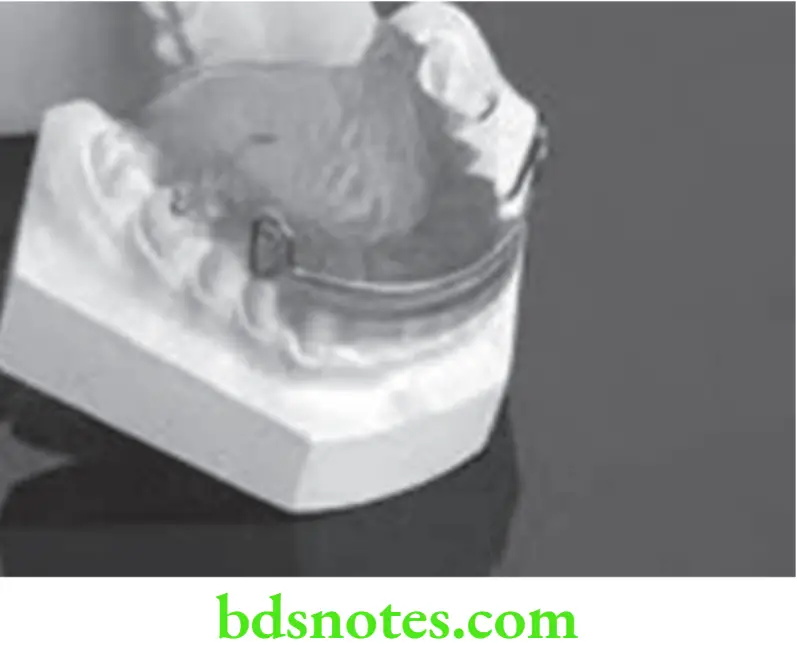
Indications
- Class 2, div 1 malocclusion.
- Class 2, div 2 malocclusion after aligning incisors.
- Class 3 malocclusion.
- Class 1 malocclusion with open bite.
- Class 1 malocclusion with deep bite.
- For post-treatment retention
- As a preliminary treatment before major fixed appliance therapy to improve skeletal jaw relations.
- Children with lack of vertical development in lower facial height.
- In crossbite correction.
- As a habit breaking appliance.
- In obstructive sleep apnea.
Contraindications
- In correction of class I problems of crowded teeth.
- In children with excess lower facial height and extreme vertical mandibular growth.
- In children whose lower incisors are severely proclined.
- In children with nasal stenosis on chronic untreated allergy of nose.
- In nongrowing individuals.
- In noncompetent patient.
- In retroclined maxillary incisors.
- In intra-arch irregularities.
Mode of Action of Activator
Following are the methods which lead to working of activator:
First Method
- Activators influence new pattrn of mandibular closure by musculoskeletal adaptation.
- Appliance loosely fis into the mouth.
- Patient has to move the mandible forwards to engage the appliance.
- This results, in stretching of elevator muscle of mastication which starts contracting thereby producing “myotactic reflex”.
- This myotactic reflex generates kinetic energy which causes:
- Prevention of further forward growth of the maxillary dentoalveolar process.
- Movement of the maxillary dentoalveolar process distally.
- A reciprocal forward force on the mandible.
Second Method: Stress to Viscoelastic Properties
- According to this theory, when force generated during swallowing and speech, it transmit and stretches blood vessels then interstitial fluid depletion occur then stretching of elastic fibers and then the force is transmitted to the bone and causes bone bending.
- This method is used in vertical activators where potential energy is used in opening of mandible, i.e. >10 mm.
Combination of Kinetic and Potential Energy
In this vertical opening is 4 to 6 mm.
Differential Eruption of Teeth
Differential eruption is caused by the selective grinding.
Advantages of Activator
- It is removable, so oral hygiene maintenance is good.
- The intervals between appointment is long.
- The appointments are usually short due to need of minimum adjustment.
- Economical.
- Treatment is possible in deciduous and mixed dentition.
- Tissue injury does not occur.
- It removes abnormal habits.
- It is weared in night only.
Disadvantages of Activator
- Require very good patient cooperation.
- Post-treatment fied appliance therapy may be required.
- Treatment time/duration is longer.
- It may produce moderate mandibular rotation (anteriorly downwards), thus not used in case of longer lower facial height.
- Not of much help in cases of crowding.
- Response is very less or it cannot be seen in older people.
- Appliance is bulky and uncomfortable.
Construction of Activator
Construction of Activator includes the following steps:
- Impression taking.
- Bite registration.
- Articulation of the model.
- Preparation of the wire elements.
- Fabrication of the acrylic portion.
- Trimming of the activator.
Impression Taking
Impressions of the upper and lower arches are made to construct two pairs of models, i.e. study models and working models.
Registration of Construction Bite
- The inter-maxillary record made to facilitate the fabrication of an activator is called as Construction bite.
- Construction bite helps in recording a three-dimensional relationship of mandible to maxilla.
- In horizontal bite (H activator) the mandible is advanced by 6 to 7 mm and vertical opening should be by 2 to 3 mm.
- In vertical bite (V activator) the mandible is advanced by 2 to 3 mm and vertical opening is by 7 to 8 mm.
- Only vertical opening is done in deep bite cases.
- In class 3 malocclusion bite is taken aftr retruding the mandible to a more posterior position.
- H activator is indicated in patient with Class 2 division 1 malocclusion having horizontal growth pattern.
- V activator is indicated in patient with Class 2 division 1 malocclusion having vertical growth pattern.
Guidelines for bite registration
Early/Mixed dentition
The mandible should be moved forward until the upper primary canine relates directly above the interproximal area between the lower primary canine and the fist primary molars. On an average, it will be 4–5 mm.
Late Mixed dentition
The mandible should be moved forward until the upper canine relates directly above the interproximal area between the lower cuspid and first bicuspid. On an average, it will be 6–8 mm.
Anterior midline
When the bite registration is taken, the upper and lower midlines should coincide. lf there is skeletal midline deviation, bite registration is done with midlines coinciding. If there is dental midline shift no attmpt should be made to correct the midlines.
Articulation of the Model
- The wax bite registration is placed on the occlusal surface between the upper and lower models.
- The models are then articulated in a reverse direction so that the anterior teeth face the hinges.
- This kind of articulation ensures sufficient access to the palatal surface of the upper and lingual surface of lower models during the fabrication of the appliances.
Labial Bow Fabrication
- The usual design requires an upper labial bow. The labial bow is made with 0.9 mm wire and consists of a horizontal section with 2 vertical loops.
- The ends of the vertical loops enter the acrylic body between the canine and deciduous 1st molar or 1st premolar. The labial bow can be active or passive.
Processing of Appliance
- The appliance consists of 3 parts—maxillary part, mandibular part and interocclusal part.
- The appliance can be fabricated by using either heat cure resin or cold cure resin. In cases of heat cure resin, the models are fist waxed and then they are flasked.
Trimming of the Activator
- Trimming the bite part of the activator should be done by the clinician.
- Planned trimming of the activator in tooth contact area is carried out to bring about dentoalveolar changes so as to guide the teeth into good relation in all the 3 planes of the space.
- Selective trimming of acrylic is done in direction of the tooth movement.
- The acrylic surface that transmit the desired force by contact with the teeth are called guiding planes. The areas of the acrylic that contact the teeth become polished.
Trimming of activator for vertical control
Selective trimming of the activator can be done to intrude or extrude the teeth.
Intrusion of teeth
- Intrusion of the incisors is achieved by loading the incisal edges of these teeth with acrylic.
- In case labial bows are used, they should be placed below the area of greatest convexity, i.e. incisally, to aid intrusion.
- In case intrusion of posteriors is needed then only the cusp tips are loaded with acrylic.
- The fossae and fisures are free of acrylic.
Extrusion of teeth
- In case of extrusion of the incisors, the lingual surface is loaded above the area of greatest convexity in the maxilla and below area of greatest convexity in the mandible.
- The extrusive movements can be enhanced by placing a labial bow above the area of greatest convexity, i.e. in the gingival 1/3rd of the labial surface.
- In case of molars, extrusion is done by loading the lingual surface above the area of greatest convexity in maxilla and below the area of greatest convexity in the mandible.
Trimming of the activator for sagittal control
Selective trimming of the activator can be done to protrude or retrude the anterior teeth and also to improve the molar relationship of the buccal teeth.
Protrusion of incisors
- In case the incisors should be protruded, the lingual surface of the teeth is loaded with acrylic and a passive labial bow is given that is kept away the teeth to prevent perioral soft tissues contacting the teeth.
- The acrylic loading of the lingual surface can be of two typesentire lingual surface is loaded (or) only the incisal portion of the lingual surface is loaded.
Retrusion of incisors
The acrylic is trimmed away from the lingual surface and an active labial bow is used to bring about retrusion of the incisors.
Movement of posterior teeth in sagittal plane
- The teeth in buccal segment can be moved mesially and distally to help in treating Class-2 and Class-3 malocclusion.
- In Class-2 malocclusion, the maxillary molars are allowed to move distally while the mandibular molars are allowed to move mesially by loading the maxillary mesiolingual surface and mandibular distolingual surface.
Movement of teeth in transverse plane
- It is possible to trim the activator to simulate expansion of the buccal segment.
- This is done by allowing the contact of the acrylic on the lingual surfaces of the teeth to be moved transversely. Better expansion is possible by placing a Jaw screw in the activator.
Question 2. Describe the philosophies ofaction ofmyofunctional appliances and fabrication of FR2 in detail.
Answer.
Frankel Philosophy of Action of Appliance
vestibular Area of Operation
According to the Frankel, dentition is influenced by perioral muscle function.
- Abnormal perioral muscle function creates a barrier for the optimal growth of dentoalveolar complex.
- Thus, when an appliance is designed to hold away the muscles from dentition, so that the dentoalveolar structures are free to develop.
Sagittal Correction via Tooth Borne Maxillary Anchorage
- Appliance is fixed on the upper arch by grooves mesial to first permanent molar and distal to the canine in the mixed dentition period.
- Presence of the lingual pad acts as postoperative stimulus and helps in the forward posturing of the mandible.
Differential Eruption Guidance
- The Frankel appliance is free of the mandibular teeth
- This allow, selective eruption of the lower posterior teeth in upward and forward directions which contributes to both vertical as well as horizontal correction of malocclusion.
Minimal Maxillary Basal Effect
Downward and forward growth of maxilla seems to be restricted even though lateral maxillary expansion is seen.
Periosteal Pull by Buccal Shield and Lip Pad
Presence of buccal shield and lip pads exert the periosteal pull which helps in bone formation and lateral expansion of the maxillary apical base.
Fabrication of FR2
FR-2 is used for treatment of class 2, division 1 and division 2.
Parts of the Appliance
Acrylic Component
- Buccal shields
- Lip pads
- Lower lingual pads.
Wire Parts
- Palatal bow
- Labial bow
- Canine extensions
- Upper lingual wire
- Lingual cross over wire
- Support wire for lip pads
- Lower lingual springs.
Fabrication Steps
Impression
- Impression should produce the whole alveolar process to the depth of the sulci, including maxillary tuberosities.
- The soft tissues and muscle attachment should be recorded carefully.
Working Model Pouring and Trimming
- Model base must extend away from alveolar process by at least 5 mm.
- Correct model trimming is necessary before appliance fabrication.
- Care must be taken not to disturb the muscle attachments.
Trimming for Lip Pads
- 5 mm from greatest curvature of alveolar base to ensure optimum extension.
- Lower relief should be 12 mm below gingival margin.
Trimming for Buccal Shield
Sulcus depth must be 10 to 12 mm above the gingival margin of posterior teeth.
Construction Bite
For minor sagittl problems, the construction bite is taken at end-to-end incisor relationship, with the mandible position forward not more than 2.5 to 3 mm.
- A clearance of at least 2.5 to 3.5 mm in the buccal segment is necessary to allow the crossover wires to pass through in Frankel appliance.
Wax Relief
- Relief is placed such that the buccal shields and lip pads stay away from teeth and tissues to achieve the desired expansion.
- Thickness of wax depends on the expansion required but should not exceed 4–5 mm in the tooth area and 2.5–3 mm in the alveolar area in the maxilla.
- In mandible only 0.5 mm of relief is given.
Wire Components
Wire components are fabricated and adapted as well as secured in place with sticky wax.
Lower lingual support wire
- Made of 1.25 mm wire.
- Horizontal reinforcing wire element contour to the lingual apical base 1-2 mm away from the mucosa and 3-4 mm below the gingival margin so as to permit adding acrylic to the pad.
Lower lingual springs
Made of 0.8 mm wire.
Lower labial wires
- Made of 0.9 mm wire.
- Act as a skeleton for lower lip pads.
Palatal bow
- Made of 1 mm wire.
- Should have a curve in the center for lateral expansion.
Labial bow
- Made of 0.9 mm wire.
- Should be 2 mm away from mucosa.
- Originate in buccal shield.
Canine loops
- Made of 0.8 mm wire.
- Embedded in buccal shield at occlusal plane level.
Upper lingual wire
- Made of 0.8 mm wire.
- It is used if the centrals are retroclined.
Acrylic Parts
- The lip pad, buccal shields, lower lingual pads are fabricated in cold cure acrylic.
- Total thickness of the acrylic should not exceed 2.5 mm.
- Lip pads should be 5 mm from the gingival margin.
Question 3. Write short note on Frankel appliance.
Or
Write short note on Frankel functional regulator.
Answer.
Frankel Appliance
Function regulator or function corrector appliance was developed by Rolf-Frankel.
- This is also called Frankel appliance, vestibular appliance and oral gymnastic appliance.
- Frankel appliance has two main treatment effects:
- It serves as a template against which the cranio-facial muscles function.
- The appliance removes the muscle forces in the labial and buccal areas that restrict skeletal growth thereby providing an environment which enables skeletal growth.
Mode of Action of FR
- Increase in transverse sagittal direction—by use of buccal shield and lip pads.
- Increase in vertical direction—by allowing the lower molar to erupt freely because appliance is fied to the upper arch.
- Muscle adaptation: The form and adaptation of the buccal shields and lip pads along with the prescribed exercises correct the abnormal perioral muscle activity.
Types of Function Regulators
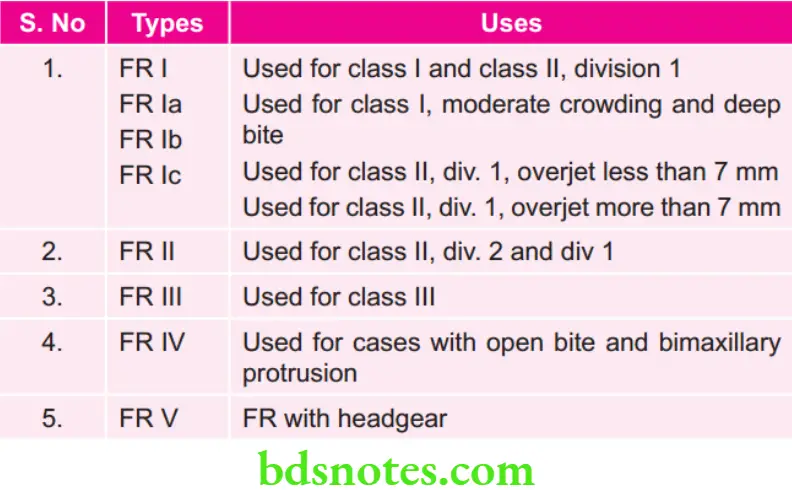
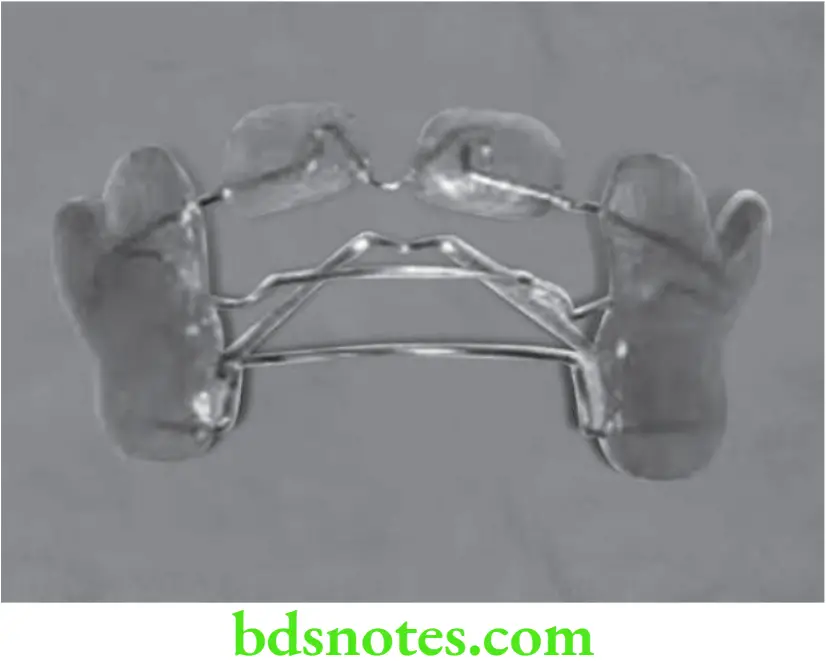
Question 4. Write short note on oral screen.
Or
Write briefly on oral screen.
Answer. Oral screen is a simple functional appliance that takes the form of a curved shield of acrylic placed in labial vestibule.
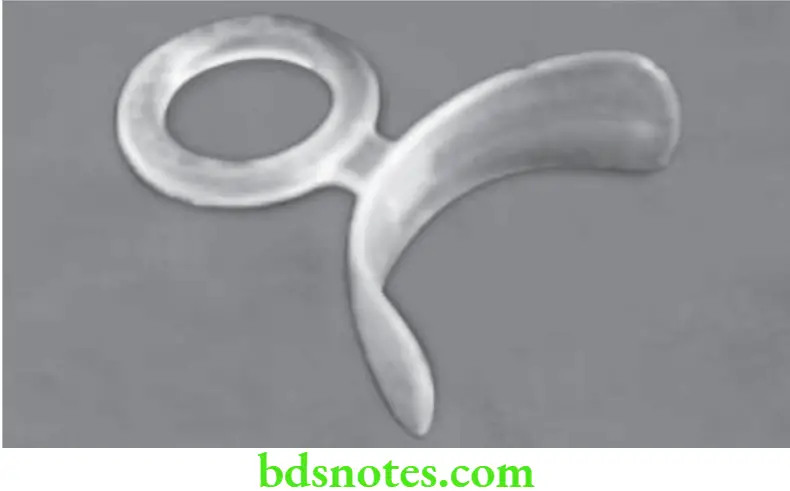
Mechanism of Action
- It prevents the pressure applied by cheeks to act over dentition. This leads the tongue to exert it forces. Passive expansion of arches occurs.
- Pressure created by lips is directed over incisors. This leads to lingual movement of labially proclined teeth.
- Forward movement of lower jaw occurs.
- Activation of hypotonic lips.
- Upper incisors get retroclined.
- Molars undergo differential eruption.
Fabrication/Construction of Appliance
- For fabrication of oral screen clear acrylic is used.
- Working models should be placed in normal occlusion.
- Wax up procedure for appliance should be carried out.
- Incisal third region of anterior teeth should not be covered with the wax.
- Wax up is done over buccal surface of teeth and alveolar process is covered with two layers of wax till distal aspect of permanent first molar in its vestibular depth.
- In primary dentition the extension of wax is till distal part of second deciduous molar.
- Curvature of appliance should lie between maxillary and mandibular incisors and in mandibular labial sulcus for the acceptance of lower lip.
- As compared to buccal vestibular sulcus depth edges should be less in thickness.
- Allowances should be created for buccal and labial frenum.
- Processing of appliance is done by either heat cure or self cure acrylic.
- Trimming and polishing of the appliance is done.
Oral Screen Management
- Patient should ask to wear the appliance in night and also at day time if it is possible for him/her.
- Lip seal is maintained for 30 to 45 minutes in a day.
Oral Screen Indications
- As active and passive appliance.
- In correction of tongue thrusting, thumb sucking and lip biting.
- For correcting mouth breathing habit.
- For correcting mild proclined incisors.
- For correction of hypotonic lip.
- For correction of mild disto-occlusion.
Question 5. Write short note on Bionator.
Answer. Bionator is a myofunctional appliance.
- Bionator was developed by “Wilham Balters“.
- Bionator is less bulky than activator and can be worn all the time except during meals.
Philosophy of Bionator
According to “BaIters”:
The equilibrium between the tongue and the circumoral muscle is responsible for the shape of the dental arches and intercuspation.
- He also said that position of tongue causes certain type of malocclusion.
- Posterior displacement causes class 2 malocclusion while anterior displacement causes class 3 malocclusion.
- The principle of bionator is not to activate the muscles but to modulate muscle activity, thereby enhancing the normal development of the inherent growth pattern.
Types of Bionators
- Standard appliance: It corrects Class 2 division 1 malocclusion.
- Screening appliance: Eliminates abnormal tongue movements in open bite cases.
- Reverse appliance: Treats Class 3 malocclusion.
Fabrication
Bionator consists of two components, i.e. acrylic component and wire component.
Acrylic Component
- Thickness of acrylic block should be minimum and thickness should not reach over tongue space.
- Acrylic begins from distal part of maxillary canine to 2mm behind distal aspect of fist molar.
- Only 2 to 3 mm of mucosa should be covered at above gingival margins of maxillary and mandibular teeth buccally.
- Joining of upper and lower part is done by interocclusal acrylic block which extends to half the area of occlusal surface of teeth.
Wire Component
- Palatal Arch
- Made up of 1.2 mm wire.
- Origin is near to upper canine.
- From upper canine it moves vertically to palatal vault.
- As it moves it join a line at center of fist premolar or deciduous fist molar and turns at distal aspect forming a loop.
- Extension is till the distal aspect of fist molar.
- The loop formed is of egg shape, horizontal and lie 1mm above the mucosa.
- Loop should follow contours of palate.
- This arch cannot be activated.
- Vestibular Arch
- Made up of 0.9 mm wire.
- Labial portion of arch should be shaped so that it should not touch the surface of incisor teeth.
- Distal to lateral incisor wire should bend downward and distal for forming buccinator loop.
- Buccinator loop prevent pressure of cheek to act over buccal segment which leads to passive expansion of arch.
- Extension of buccinators loop is till the embrasure in between deciduous second molar and permanent first molar in upper arch.
- Here it forms a 90° round bend and run from all the crowns to embrasure between canine and deciduous first molar or fist premolar.
- At deciduous fist molar or premolar it is merged to acrylic.
Bionator Management
- It is weared in both day and night and should be removed during meals.
- Time interval between appointments is 3 to 4 weeks.
Bionator Indications
- In class 2 division 1 malocclusion because of retruded mandible.
- In class 3 malocclusion
- In open bite due to functional causes.
Bionator Contraindications
- Class 2 relationship due to maxillary prognathism.
- In vertical growth pattern.
- In labially tipped lower incisors.
- In anterior crowding.
Bionator Advantages
- Appliance is less bulky.
- Can be worn full time except during meals.
- Appliance exerts a constant inflence on the tongue and perioral muscles.
Bionator Disadvantage
Difficulty in correct managing of appliance.
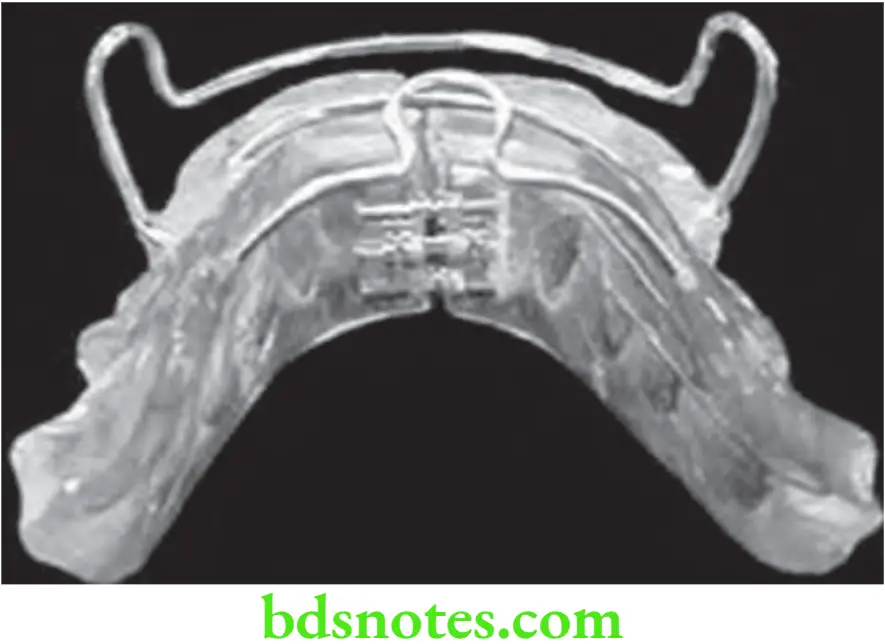
Question 6. Write short note on visual treatment objectives.
Answer. This is an important diagnostic test undertaken before making a decision to use a functional appliance.
- This test enables us to visualize how the patients profile would be after functional appliance therapy.
- An improvement in profile means positive visualized treatment objective and functional appliances are indicated.
Class 2 visualized Treatment Objective
- It is performed by asking the patient to bring the mandible forward.
- Change of appearance of patient is marked from two levels, i.e. first from edge-to-edge position and another from midway between the present occlusion and edge to edge position.
- An improvement in profile is present from edge-to-edge position it means problem is in mandible. It is a subject mandibular retrognathism. Functional appliances which stimulates mandibular growth should be given.
- If profie improves in midway, the subject is of maxillary prognathism and mandibular retrognathism. Appliances such as twinblock with headgear is advised.
- In case the profile worsens at edge-to-edge it means problem is in maxilla. It is a subject of maxillary prognathism. Appliances such as headgears should be advised.
Class 3 visualized Treatment Objective
- In patients with Class 3 malocclusion, cotton rolls are kept in upper labial vestibule.
- If patient has retrognathic maxilla proflie improves with cotton roll.
- If patient has mandibular prognathism his profile worsens with cotton roll.
Question 7. Classify Frankel regulator. Describe in detail the indication, mode of action, constructional components and duration of wear of FR 2.
Answer.
Duration of Wear of FR 2
- For first two weeks appliance should be weared for 2 to 3 hours in day time.
- For next three weeks appliance should be weared for 4 to 6 hours in day time.
- After three weeks appliance should be weared for 3 to 4 months initially.
- As hyperactivity of the muscle subsides appliance should be weared in night.
Question 8. Write short note on Denholtz appliance.
Answer. When the lip bumpers are used in the maxillary arch such an appliance is called as Denholtz appliance.
The lip bumper can be custom made using 0.9 mm hard round stainless steel wire.
Uses
- They are used to augument anchorage.
- Distalization of fist molars can be achieved.
Appliance Design
The appliance is made up of thick stainless steel wire extending from the one molar to the opposite molar. The wire is made to lie away from the anterior teeth so that the lips are kept away from the teeth. The lip bumper is inserted into round molar tubes of 0.93 mm diameter soldered to bands on the fist molars. The portion of wire from canine to canine can be reinforcedn with acrylic.
Question 9. Briefly differentiate between activator and twin block.
Answer.
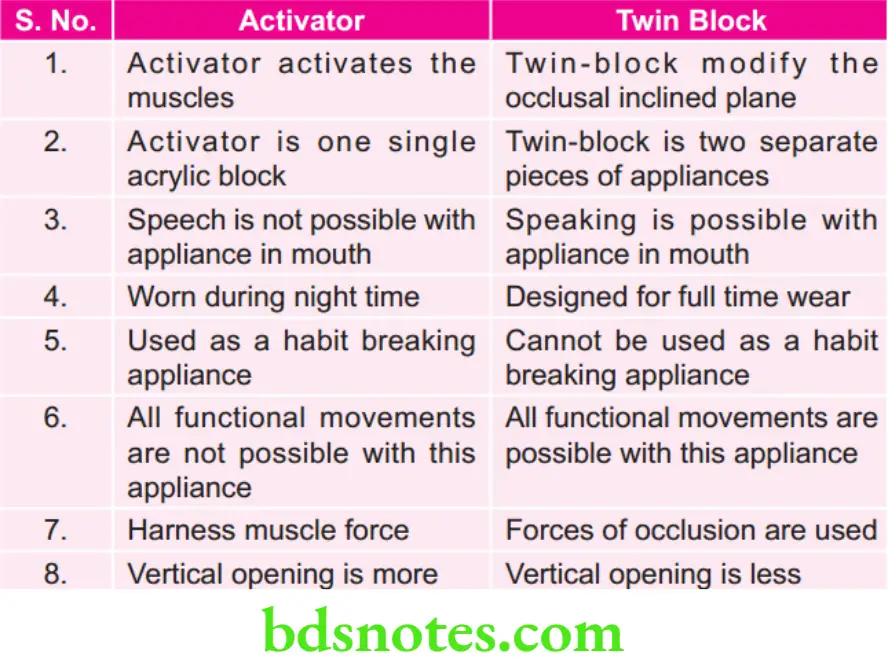
Question 10. Write short note on oral screen and its modifications.
Answer.
Modifications of Oral Screen
- Oral screen with breathing holes
- Breathing holes are placed on labial aspect of oral screen.
- Button with a string attached to it is given on lingual aspect of oral screen.
- Patient is told to do exercise by pulling string through the breathing hole.
- Oral screen in open bite
- An acrylic projection is attached to oral screen so that tongue remains away from dentition due to the acrylic projection.
- Hotz modifications
- Oral screen is fabricated with a metal ring which is projected between upper and lower lips.
- Rehak modification
- Oral screen is fabricated with a nipple which usually projects outwards.
- Nipple is retained by the lips. So that the natural sucking movements enhances the effects of oral screen.
- Double oral screen
- In this oral screen is modified in such a way that there is an additional screen attached to it lingually by two 0.9 mm thick wires that run through the bite in lateral incisor area.
- Used in treatment of tongue thrusting.
Question 11. Define myofunctional appliances. Give its classification. Briefly describe the twin block myofunctional appliance.
Or
Define myofunctional appliances. Classify and explain in detail on twin block.
Or
Define myofunctional appliance and classify myofunctional appliance. Define twin block appliance.
Or
Define and classify myofunctional appliances. Describe construction bite, indication and design of twin block in detail.
Or
Write short answer on twin block appliance.
Answer.
Twin Block Myofunctional Appliance
- Twin block myofunctional appliance was discovered by Scottsh orthodontist, Mr. William Clark.
- These are simple bite blocks which modify occlusal inclined plane.
- They should be weared for full time.
Types of Twin Block
- Standard
- Sagittal
- Reverse
- Magnetic.
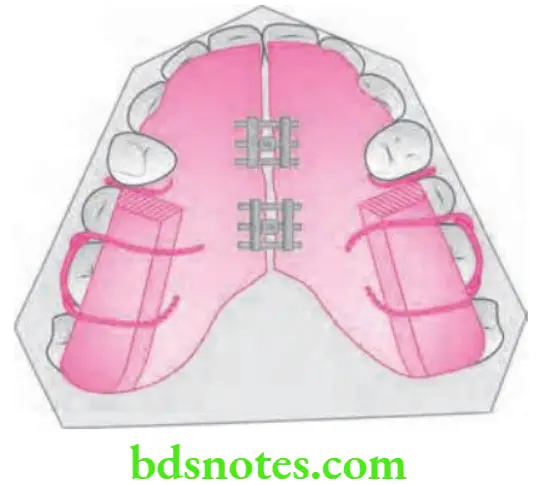
Design
Parts of twin block are: (1) Acrylic part which consists of base plate and occlusal inclined plane, (2) Wire component which consists of labial bow, delta clasp and ball end clasp.
Acrylic Part
Twin block is the combination of two separate appliances.
Twin block consists of upper and lower occlusal inclined planes which lock at 70 degree to occlusal plane.
Upper inclined plane
- It is angled from mesial surface of lower fist molar.
- Flat part of inclined plane passes distally above the remaining posterior teeth in form of wedge.
- It only covers lingual cusps of posterior teeth.
Lower inclined plane
- In this lower molars are free to erupt.
- Buccolingually it covers the occlusal surface of lower premolars and deciduous molars.
- It must be clear of mesial surface which is contacting with the lower molars.
Wire Component
Clasps
- Initially Adam’s clasp were in usage.
- These days delta clasps are preferred in lower premolars and upper fist molar.
- In mandibular anterior region ball end clasps are used.
Labial bow
- It can be used optionally.
- Its main aim is to achieve retention.
- Used in cases of proclination.
Construction bite
- Horizontal bite should be taken edge-to-edge.
- In vertical opening 2 mm interincisal clearance should be present.
- In premolar area 5 mm clearance should be present.
Other Attachments to Twin Block Which are Optional
- Headgear: Used in cases where maxilla should be extruded or intruded.
- Expansion screw: In cases where maxillary arch get constricted or in cases where the horizontal mandibular advancement leads to crossbite.
- Concorde facebow: In cases where combined extraoral and intermaxillary traction is used.
Myofunctional Appliances Management
Management of patient by twin block should be done in three phases, i.e.
- Active phase: Treatment by twin block for 6 to 9 months.
- Supportive phase: Treatment by twin block for 3 to 6 months is done and after that upper anterior inclined plane is given to patient.
- Retention phase: Regular retention appliance is given for duration of 9 months.
Myofunctional Appliances Indications/Uses
It is used in following conditions:
- Class 2 div 1 and 2 malocclusions.
- Class 3 malocclusion.
- In TMJ problems.
- In Class 1 open and closed bites.
- In lateral arch constriction cases.
Question 12. Write short note on lip bumper.
Answer. It is also known as lip plumper. It is a functional component which is used with upper or lower fied appliance.
Types
Based on availability of removal.
- Combined fixed removable: Portion of lip bumper is removed from fixed part.
- Component of fixed appliance: Lip bumper is soldered to molar band where it cannot be removed separately.
Based on Arch Used
- Maxillary lip bumper or Denholtz appliance.
- Mandibular lip bumper.
Design
- Lip bumper is the vestibular arch which has acrylic pad attached to lower molar bands.
- Acrylic pad is placed 2 to 3 mm away from gums as well as teeth.
- Appliance should be 4 mm below cervical margin of mandibular incisors.
- Wire used has diameter of 0.93 mm.
- Wire should be soldered or be inserted in molar tube with the help of U bend or coil springs.
Mode of Action
- Use in cases where upper or lower lips are problematic.
- It prevents hyperactivity of mentalis muscle in the manner as vestibular screen do.
- Prevents abnormal forces acting over incisors.
- It leads to proclination of incisors and distalization of the molars.
Lip Bumper Indications/Uses
- In lip traps.
- For uprighting molars.
- For reduction of overjet due to proclination of the incisors.
- For distalization of molars.
- As space regainers in mesial drif of fist molar.
- As anchorage saver.
Question 13. Write short note on inclined plane.
Or
Write short note on mandibular anterior inclined plane.
Or
Write short note on Catalan’s appliance.
Answer. It is designed to produce stress lateral to long axis of teeth. Teeth movement by inclined plane is in labial direction.
Types of Inclined Planes
- Upper anterior inclined planes.
- Lower inclined planes:
- Cemented inclined plane or Catalan’s appliance.
- Removable inclined plane.
Upper Anterior Inclined Planes
- It appears as a flat anterior bite plane.
- Anterior inclined plane engage lower incisors and leads mandible to slide anteriorly.
- It consists of 45 degree angulation with seating groove for mandibular incisors so that it reduces labial tipping of incisors.
- It can also function as retention appliance aftr completion of functional appliance therapy.
Lower Inclined Plane or Catalan’s Appliance or Cemented Inclined Plane
- This appliance was discovered by Catalan.
- It is indicated in correction of the anterior crossbite.
- It cannot be worn for more than three weeks.
Method of Fabrication
- Working models should be constructed.
- Design of inclined plane is made at model. Design of inclined plane is such that it include tooth and half the crossbite area over both sides.
- Wax up of inclined plane is carried out.
- It should lie 45° to occlusal plane.
- Posterior extension is such that the patient should be prevented from biting in retruded position.
- Now the incline plane is acrylized.
- At time of insertion, bite should not be more than 4 mm.
- As appliance is fiishes it should be cemented with zinc oxyphosphate luting cement.
- Patient should be recalled after one week
- Correction is accomplished in the time of two weeks.
Inclined Plane Indication
When incisors erupt and overbite is good.
Inclined Plane Contraindication
In cases where overbite is less.
Inclined Plane Advantages
- Relapse is absent or is very less.
- Fabrication is easy.
- Crossbite is corrected very fast.
- Trauma to tooth is very less.
Inclined Plane Disadvantages
- Difficulty in speech.
- Patient feels difficulty in eating.
- Alignment of teeth is not precise.
- If appliance remains in mouth for long duration it causes anterior bite.
Removable Inclined Plane
- Used very frequently.
- It provides good results.
- During its fabrication an inclined plane is attached to removable mandibular Hawley appliance at 45° to occlusal plane.
- For retention clasps are added.
Question 14. Classify the myofunctional appliances. Write the mechanism of action of Frankel appliance.
Answer.
Mechanism of Action of Frankel Appliance
It is studied under various headings:
- Vestibular Area of Operation
- According to Frankel malocclusion occur due to disturbed muscle imbalance and posture.
- Buccal shields and lip pads both of them grab labial and buccal muscles and prevent disturbed muscle force to act on teeth.
- As restrains are removed arches undergo outward movement.
- In this way it act as oral gymnast device by correcting disturbed muscle posture.
- Anteroposterior Corrections
-
- It stimulates the lateral pterygoid muscle and increases its activity. This causes growth of condylar cartilage which leads to the deposition of bone in condyle posteriosuperiorly. This causes sagittal growth of mandible.
- Decrowding at Time of Eruption
-
- Vestibular screens should be extended to sulcus and create tension in soft tissues which causes outward bending of thin buccal plate leading to outward drifting of teeth.
- Differential Eruption
-
- Differential eruption in case of mandibular molars leads to accurate sagittal relation the value of which is ranges from 1 to 2 mm.
- Restraining Effct on Maxilla
-
- The restraining effect lies both over the teeth and maxillary arch.
- Stimulation of Periosteal Matrix
-
- As the tension is created due to the extension of buccal shields and lips in vestibule, there occurs periosteal pull which leads to bone deposition.
- By stimulation of periosteal matrix expansion of maxillary arch and extension of lower anterior part occur.
Question 15. Differentiate between activator vs Frankel appliance.
Answer. Following is the difference:
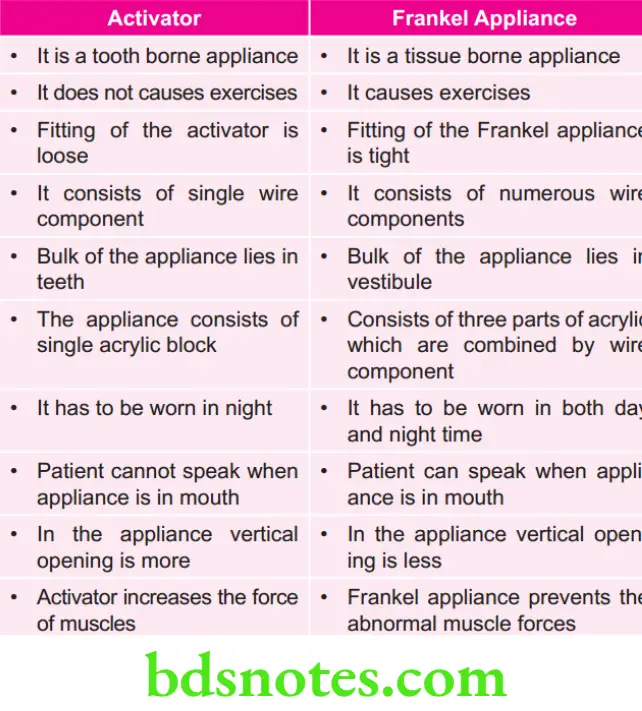
Question 16. Write short note on Frankel 2.
Answer. Frankel 2 is most commonly used appliance. It is used in the treatment of Class II division 1 and division 2 malocclusion.
Fabrication of FR2
FR-2 is used for treatment of class II, division 1 and division 2.
Parts of the Appliance
Acrylic Component
- Buccal shields.
- Lip pads.
- Lower lingual pads.
Wire Parts
- Palatal bow.
- Labial bow.
- Canine extensions.
- Upper lingual wire.
- Lingual crossover wire.
- Support wire for lip pads.
- Lower lingual springs.
Question 17. Define and classify myofunctional appliances. Describe vestibular screen in detail.
Answer.
Vestibular Screen
- Vestibular screen is also known a lip modular.
- Vestibular screen extends in vestibule and lies in contact with alveolar process.
- There are no teeth in contact with vestibular screen.
Mechanism of Action
- Vestibular screen prevents pressure from cheek to act on dentition. Due to this, tongue becomes free to exert the force. This leads to the passive expansion of the arches.
- Pressure from lips becomes directed to incisors. This pressure leads to lingual movement of labially proclined teeth.
- Lower jaw move forward.
- Hypotonic lip gets activated and tonicity of lips improved.
- Maxillary incisors get retroclined.
- Apical base gets passively expanded.
- There is differential eruption of molars.
- When protrusive bite is taken there is mandibular advancement.
Construction of the Appliance
- Appliance should be constructed in the clear acrylic.
- Place the working model in normal occlusion or take the
- protrusive bite for Class II division 1 malocclusion.
- Wax up of the appliance is carried out.
- Appliance directly influences the anterior segment due to this incisal third of anterior teeth is not covered by the wax.
- Appliance does not influence the posterior segment directly. It acts by remaining away from the appliance. To effect the change, buccal surface of the teeth and the alveolar process are covered by two layers of wax till distal aspect of fist permanent molar in permanent dentition. It extends to the vestibular depth.
- In deciduous dentition appliance extends till distal surface of second deciduous molar.
- Provide the correct curve between upper and lower incisors and lower labial sulcus to accept lower lip.
- Make the edges less thick than buccal vestibular sulcus depth.
- Allowances are made for labial and buccal frena.
- Process the appliance with heat cure or self cure acrylic.
- Trim and polish the appliance.
Adjustment of Appliance
- Appliance should be worn by patient every night and during day when possible.
- Lip seal exercises should be carried out for 30 to 45 minutes/day.
- Breathing holes should be reduced in size.
- Areas where tooth contact is present, padding with quick setting self cure acrylic is done.
Uses of vestibular Screen
- As active and passive appliance.
- For correcting tongue thrusting, thumb sucking and lip biting habits.
- For correcting mouth breathing, thumb sucking and lip biting habits.
- For correcting mild distocclusion.
- For correcting flccid hypotonic orofacial musculature.
- For counteract the deficiencies in lip posture and function.
- For correcting mild proclination of incisors.
Advantages of vestibular Screen
- Appliance is simple and versatile during early interceptive treatment.
- Oral screen provides good muscle balance between tongue inside and buccinators mechanism outside.
- It corrects the faulty relationship of upper and lower lips to each other and near normal lip seal is possible.
- It leads to the development of proper functioning occlusion.
- It provides effective mechanism for eliminating hyperactive mentalis activity.
Disadvantages of vestibular Screen
- Does not provide complete mechanotherapy.
- It is only the phase I correction of an orthodontic problem.
Question 18. Write short note on removable and fied functional appliance.
Answer.
Removable Functional Appliances
- Activator, twin block, bionator, Frankel are all removable functional appliances.
- Activator is a loose fitting appliance and activates the muscles. It harnesses the muscle force.
- Twin blocks correct the maxillomandibular relationship through functional displacement. Twin blocks are two separate pieces of appliance, i.e. they are simple bite blocks which modify the occlusal inclined plane effiently. Twin blocks produce rapid functional correction of malocclusion by guiding mandible forward in the correct position.
- Bionator is an activator derived device. It less bulky and is elastic as compared to activator. Bionator modulates the muscle activity which enhances the normal development. The appliance consists of an acrylic component and wire component.
- Frankel appliance is confined to oral vestibule. Buccal and lip shields prevent the aberrant muscular force from acting on teeth.
Fixed Functional Appliances
- Fixed functional appliances were introduced by Emil Herbst.
- Fixed functional appliances are known as non-compliance Class 2 correctors.
Classification
Fixed functional appliances are flexible fixed functional appliance and rigid fied functional appliance.
Flexible Fixed Functional Appliances
- These are intermaxillary torsion coils or fixed springs.
- Elasticity and flexibility are the main features of this group.
- These appliances lead to the greater movement of the mandible.
- Lateral movements can also be made
- These appliances are indicated in Class II Div 1 malocclusion, Class II Div 2 malocclusion, in Class III malocclusion.
- Examples are Jasper Jumper, Amoric torsion coil, Klapper super spring, Bite fixer, etc.
Rigid Fixed Functional Appliances
- These appliances do not allow patient to close in the centric relation.
- These appliances provide 24 hours stimulus for mandibular growth.
- These appliances do not fracture easily.
- Examples are herbst appliance, Cantilever bite jumper, Biopedic appliance, Ritto appliance, etc.
Question 19. What are functional appliances. Write their advantages and disadvantages.
Answer.
Advantages of Functional Appliances
- It enables the elimination of abnormal muscle function in this manner it aids in normal development.
- Treatment should be started at an early age mainly in mixed dentition period.
- As the treatment begins at early age, psychological disturbances associated with malocclusion can be avoided.
- These appliances are fabricated in dental laboratory, so less patient chair time is required.
- Frequency of patient’s visit to an orthodontist is less in case of removable and fixed appliances.
- Oral hygiene maintenance should not be interfered by the functional appliances.
- Patient acceptance of functional appliances is good as they are worn in the night by patient.
Disadvantages of Functional Appliances
- They should not be used in adult patients as their growth has ceased.
- They are not used for individual tooth movement.
- Most of the functional appliances depend on the patient for the timely wear. Patient corporation is essential for success of treatment.
- They can need pre-functional orthodontic tooth movement for correction of minor local irregularities which can interfere with functional therapy.
- Fixed appliance therapy can be needed at the termination of treatment or final detailing

Leave a Reply